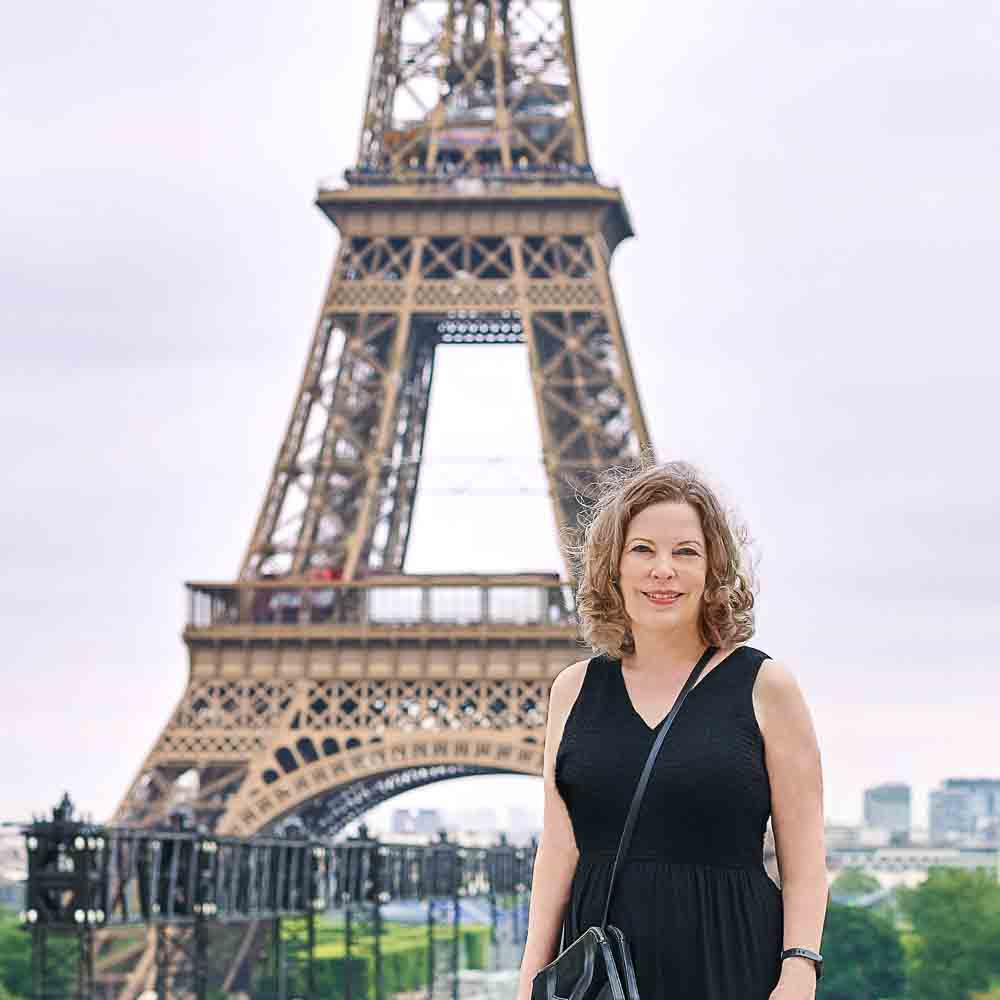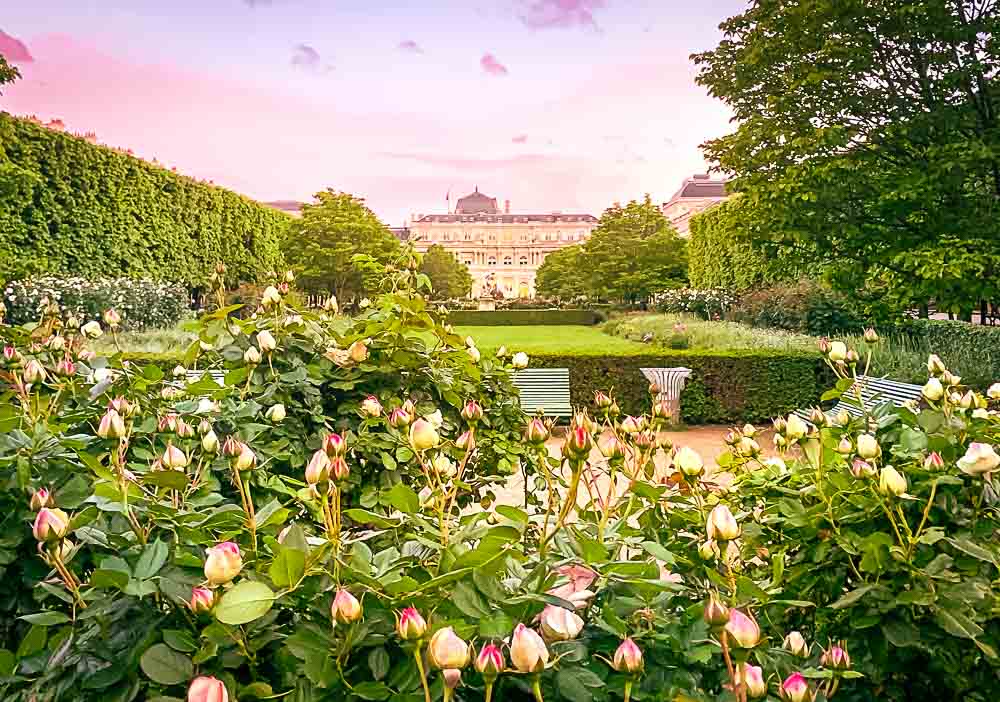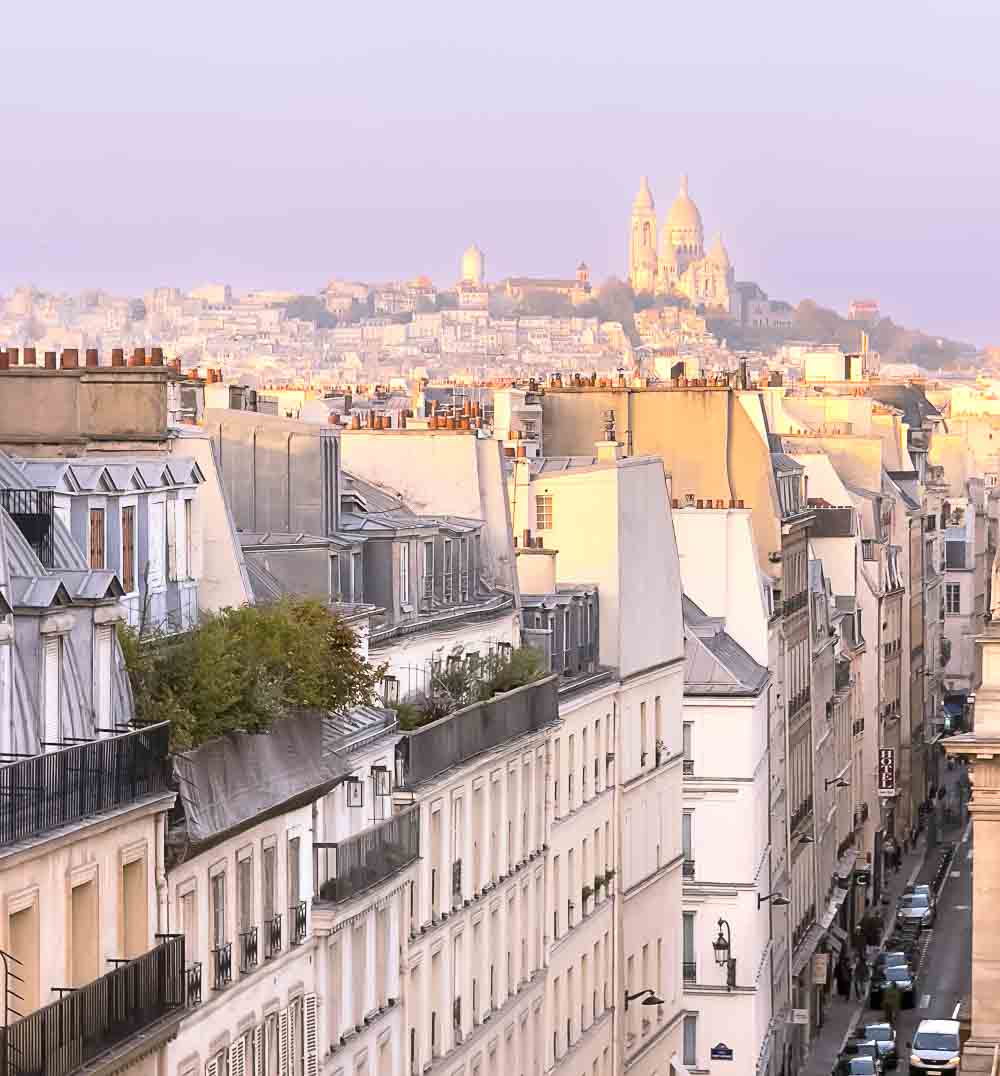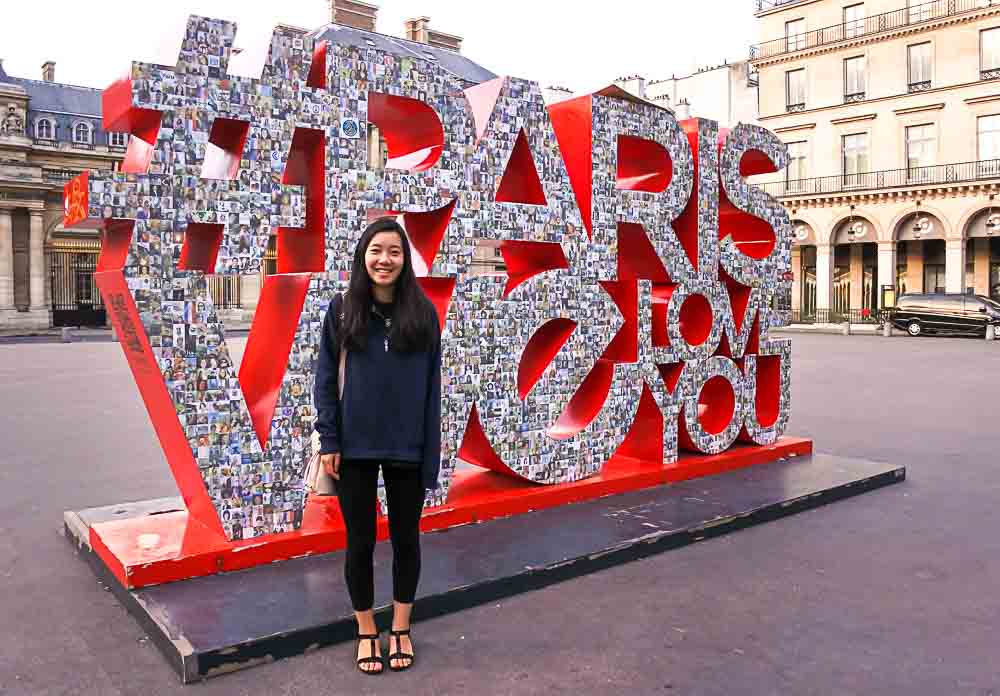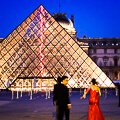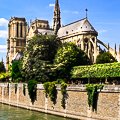The Palace of Versailles (Chateau de Versailles) is Europe's most spectacular castle and also holds a special place in history due to its famous occupants, including Louis XIV, Louis XVI, and Marie-Antoinette.
No other place in the world can match Versailles Palace's combination of dazzling beauty, historical significance, and over-the-top extravagance. It has been open for tours since 1793 and today receives around 15 million visitors each year.
In case you're wondering if Versailles is worth visiting, the answer is a big Yes! This vast French palace and its estate are packed with so many wonderful things to discover and experience that it may rightfully top your Paris bucket lists. As a bonus, it's easy to reach for a day trip - or even a half-day visit.
Once you explore Versailles, you probably won't feel surprised to learn that the "Sun King," as Louis XIV liked to call himself, put France on the road to eventual bankruptcy and revolution when he created it from his family's simple hunting lodge.
What's the Best Way to Visit Versailles Palace?
Guided tours will whisk you through a fast-access gate, lead you past the crowds, and make sure you don't miss anything. If this is your first visit, consider a tour which includes transportation from Paris. Here are 7 popular walking and bike tours:
- Full-Day Guided Tour of Versailles by private luxury bus from Paris
- Skip-the-Line Versailles Palace Guided Tour by train from Paris
- Versailles Palace & Gardens: Ticket & Audio Guide by private luxury bus from Paris
- Day Trip to Giverny & Versailles Palace & Garden by private luxury bus from Paris
- Versailles Bike Tour with Palace & Queen's Farm Entrance by train from Paris
- Versailles Sunset Bike Tour with After-Hours Palace Admission & Fireworks Show by train from Paris
- Versailles Palace & Gardens Skip-the-Line Guided Tour - no transportation
Prefer to explore Versailles on your own? Save time by getting a reserved-access "Passport" entry ticket the Palace, Garden, and other ticketed areas online.
Inside the Palace of Versailles, fully-restored rooms such as the King's and Queen's sumptuous apartments, the soaring Grand Chapel with its breathtaking vaulted ceiling and golden pipe organ, and of course the dazzling Hall of Mirrors give you plenty of reasons to linger.
Plus, lots more to see inside, as well as elegant restaurants where you can relax over a meal and savor Marie Antoinette's favorite drink: chocolat chaud (hot chocolate).
But the Palace, magnificent as it is, occupies just one small part of the chateau's immense 2,000+ acre estate you can explore today. Two other smaller castles (the Grand Trianon and Petit Trianon), vast gardens filled with numerous statues and fountains, a mile-long body of water called the Grand Canal, and even a fascinating replica of a small French village created for Marie Antoinette and her friends give you many more fascinating places to see.
As an added bonus, you can enjoy 21st century recreation and culture: paddle boats in the Canal's basin, concerts, art and Musical Gardens and Musical Fountains shows, including a beautifully illuminated night version with fireworks on Saturday nights, bikes, and even golf carts to rent while exploring the grounds.
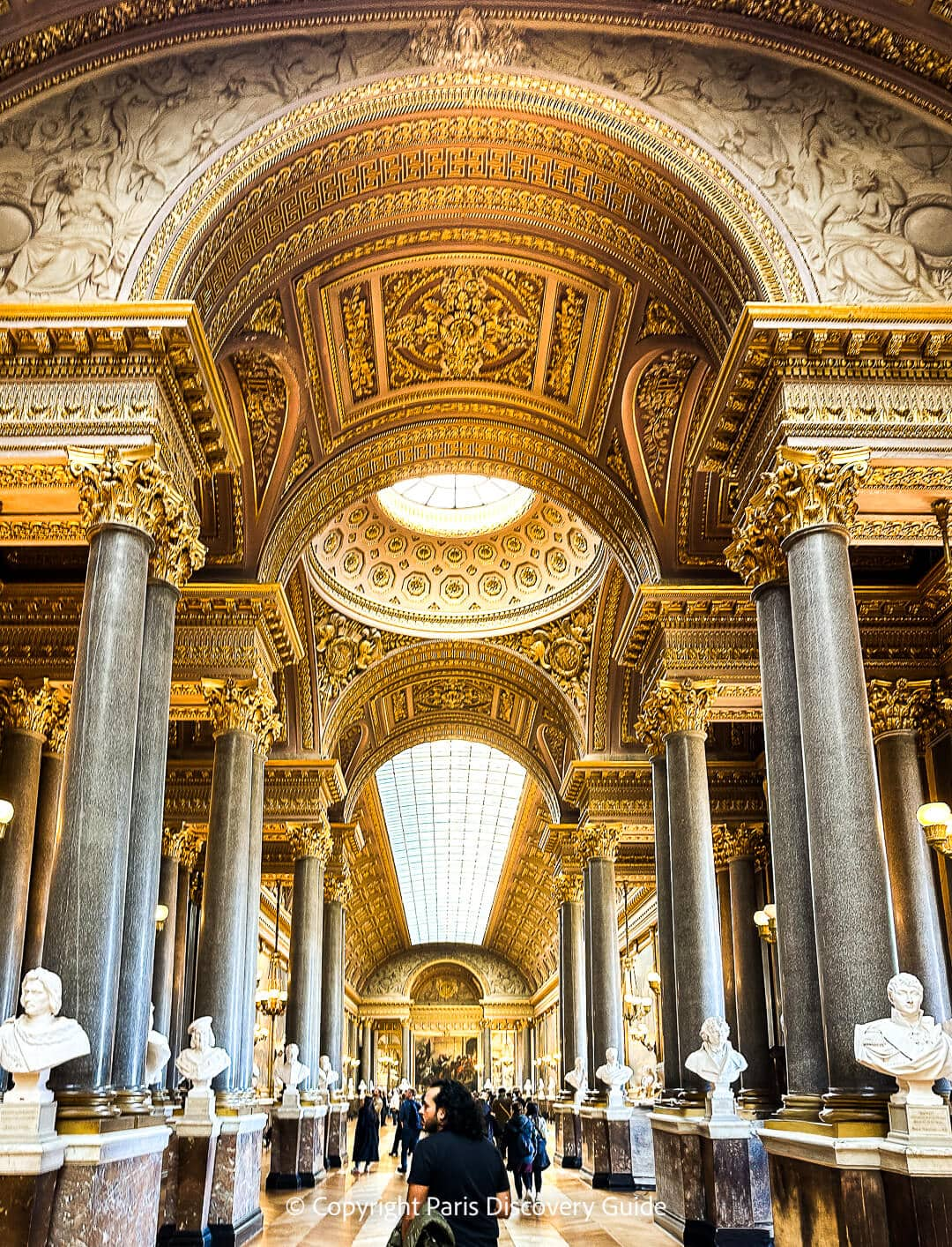
But here's the challenge when visiting Versailles: with so many attractions, how do you choose what to explore if you don't have time for everything?
We can't answer that question for you because we don't know what you'll like best- but we have compiled a list of 15 fantastic things to experience inside the Palace and beyond.
Want to enjoy them all? Plan to spend 2 or 3 days at Versailles (you'll find hotel recommendations below; as a bonus, you'll usually save money by staying in Versailles instead of Paris).
For shorter visits, pick the attractions and activities you like the most!
Why Did Louis XIV Create the Palace of Versailles?
Above all, the sumptuous, spare-no-expense Palace reflects Louis's belief in his god-like status, his divine right to rule, and his absolute power. In case you're wondering, he called himself the "Sun King" because he believed that France revolved around him like the earth revolves around the sun.
But he also had a somewhat sneakier reason for expanding the Palace of Versailles' size to be large enough to house his entire royal court of 5,000 and to provide office space for up to another 5,000 more people: by keeping the potentially treacherous nobility confined in one place right under his nose, so to speak, he could control them far better than if they lived in Paris.
While today we may recognize that Louis squandered France's resources to prop up his own vanity, the politically-savvy king viewed his expenditures as an investment to ensure his continued right to rule. One of his core beliefs appears to have been: "Keep your friends close, and your enemies closer."
Top photo: Palace of Versailles, (c) Paris Discovery Guide
Paris Discovery Guide is a reader-supported publication. When you buy through my links, I may earn a small commission at no additional cost to you. Merci beaucoup for your support!
The 15 Most Fantastic Things to Experience at Versailles
Although the Palace of Versailles and its surrounding gardens and forest are packed with spectacular things to see, it's also almost always very crowded. If you just on seeing as much as possible, you run the risk of it becoming just a blur in your memory.
Therefore, we've put together the following list of 13 things to experience at top locations within Versailles - inside the sumptuous chateau, outside in the gardens, and elsewhere on the estate.
1. Hall of Mirrors (Galeries des Glaces)
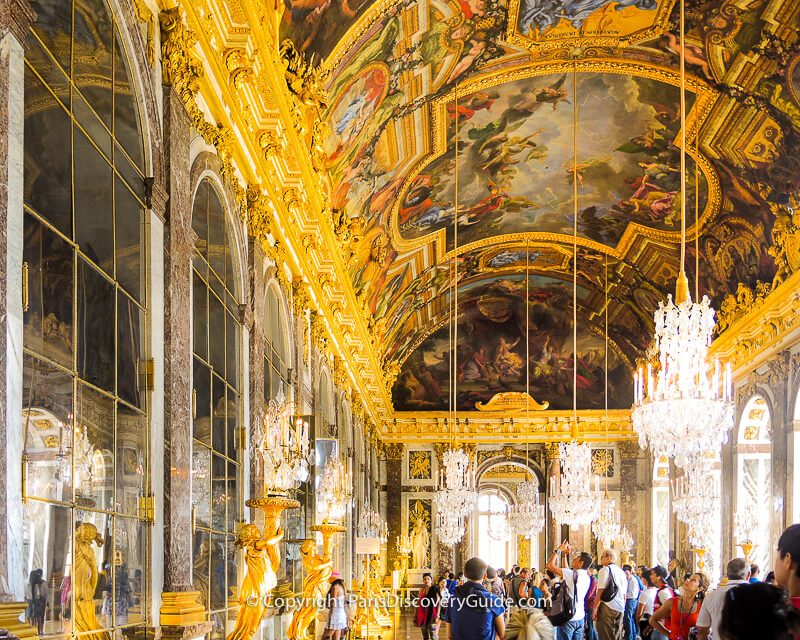
By far, the most famous top sight inside the Palace of Versailles is the unforgettable, dazzling, over-the-top splendid Hall of Mirrors. Photographs do not do it justice. The experience of standing in the Hall's vast space and seeing reflections of light, massive quantities of gold and crystal, and endlessly multiplying images in the silvery mirrors wherever you look is totally unique.
Glance up, and you'll see vivid paintings - 30 in total - spread across the room's vaulted ceilings. In the 21st century, their meaning isn't readily apparent. But 17th century viewers would have instantly understood their purpose: a celebration of Louis XIV's military and diplomatic victories.
In case you're interested in numbers, the 17 arches stretching across the wall opposite the windows contain a total of 357 mirrors.
What did Louis XIV and later French kings use the Hall of Mirrors for?
Not as much as you might imagine, given its splendor. On a day-by-day basis, courtiers and visitors used it as a passageway. It also came in handy for the lavish balls held after royal weddings.
Perhaps even more important at that time, the huge number of large mirrors lining the "La Grande Galerie" functioned as a not-so-subtle brag about France's manufacturing capabilities at a time when Venice filled its coffers with revenues from mercury glass mirrors created by its highly prized craftsmen.
However, the most significant event in the Hall of Mirrors happened long after the French had rid themselves of the royalty. In 1919, German delegates came here and signed the Treaty of Versailles before representatives from France, the U.S., Great Britain, Italy, and 28 other nations to officially end World War I.
Unfortunately, historians now consider that the treaty's conditions set in motion the rise of fascism and World War II - but that sober fact does nothing to tarnish the beauty of the most famous room in the Palace of Versailles.
Ready to book your day trip to Versailles? This guided tour whisks you there and back by train - a stress-free way to get there and explore with your expert guide.
Check availability:
2. King's State Apartments
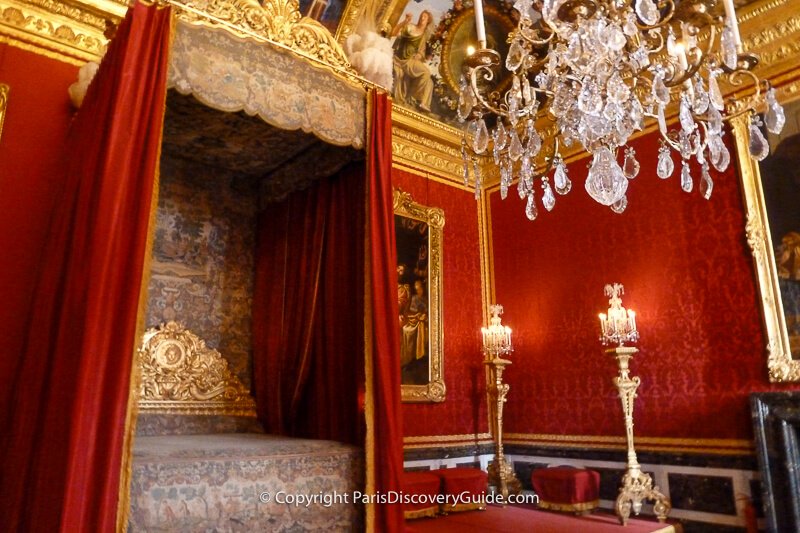
Your visit to Versailles will likely include walking through the King's State Apartment.
As you explore the series of seven sumptuous rooms, take a moment to consider: you're literally following in the footsteps of countless officials and sovereigns from across Europe back in the days when Louis XIV received visitors here.
Each opulent chamber practically drips with crimson and gold Italianate furnishings, priceless paintings, and crystal chandeliers, all designed to impress.
But did Louis actually live in the King's State Apartment? Not really. He used it primarily for ceremonial purposes and formal entertainment - and of course, to reinforce his Sun God image.
After his visitors left, he retreated to a smaller, more intimate suite of rooms designed for his personal use. Here, he displayed his favorite paintings and enjoyed more privacy. His successors, Louis XV and Louis XVI, later expanded these private quarters by creating more rooms for their personal use and entertainment, including libraries, dining areas, laboratories, scientific galleries, and even a game room.
Unfortunately, these small rooms are not normally available to see. But when you tour the admittedly spectacular crimson State Apartment, dripping with gold, mirrors, and crystal chandeliers, remember: they're just the public façade, intended to awe, impress, and intimidate.
The actual man behind the Sun King preferred a simpler environment.
3. Queen's State Apartments
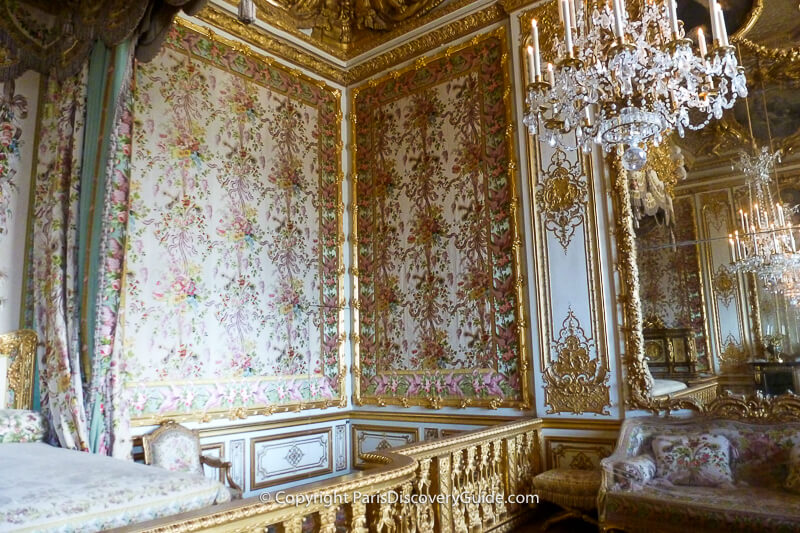
Although the Queen's Apartment once mirrored the layout of the King's State Apartment, it now consists of only four splendid rooms.
When you enter the Queen's Bedchamber, you will immediately notice a striking difference in decor. The King's quarters featured rich dark tones and ornate paneling in vogue during Louis XIV's reign in the 17th century.
In contrast, this area practically glows from the light floral prints and pale tones favored by Queen Marie-Antoinette when she redecorated her apartment nearly 100 years later.
What is remarkable is the room's authenticity. The fabrics used for wall and bed hangings are exact copies of the original, re-woven in Lyon. The jewelry cabinet belonged to Marie-Antoinette. You can still gaze at the family portraits she put up of her mom, Empress Maria-Theresa of the Holy Roman Empire, and her brother, Emperor Joseph II.
Marie-Antoinette spent most of her time in the spacious bedroom when she was at the Chateau. This is where she slept, received guests, and even gave birth on a temporary bed brought in for that specific purpose.
However, when she wanted to dine and relax with her friends, she retreated to her own special place, the Hamlet. More about that in a moment!
More about Visiting the Palace of Versailles
4. The Royal Chapel
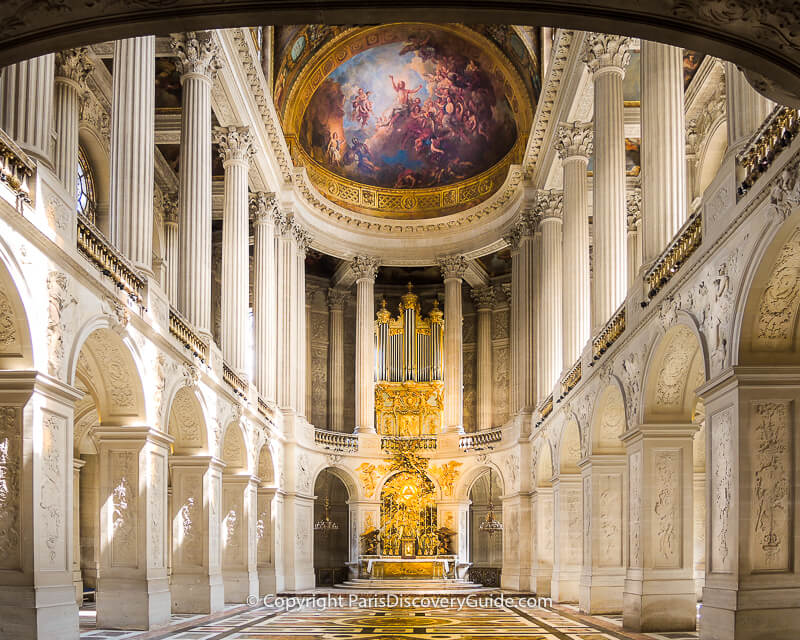
The Royal Chapel that you see today is actually the fifth one to be built at Chateau. Its construction took over two decades, with more than 110 sculptors and other artists working on the ornate sculptures, paintings, and ornamentation, and completed in 1710. Master organ-maker Clicquot designed the Chapel's renowned pipe organ.
The Chapel soars to 144 feet in height, making it the tallest part of the palace. Like Sainte-Chapelle and other French palace chapels, it features two levels.
The royal family attended mass on the upper level, which would have given them excellent close-up views of the magnificent painted ceilings and domes. However, according to the custom of those times, other court members and the public watched from the somewhat less-grand ground floor.
When you look at the Royal Chapel from the upper-level observation point used for public viewings, take a moment to imagine the Royal Chapel during its most famous event.
In 1770, 14-year old Marie-Antoinette married the 15-year old Dauphin (later known as Louis XVI) here in front of over 5,000 guests. She wore a lavender dress adorned with diamonds and pearls, and he sported a silver suit. After the ceremony, a crowd of 200,000 watched fireworks on the Estate's grounds.
5. Art at Versailles Palace
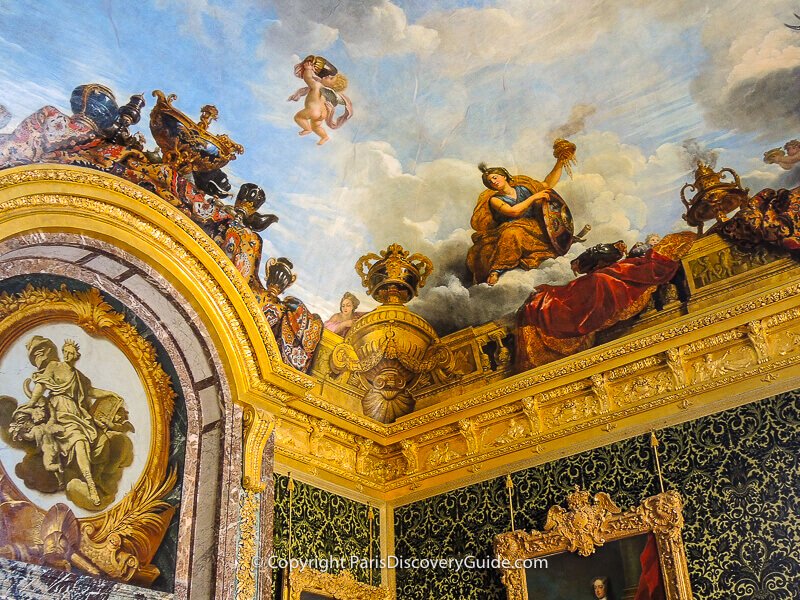
As you explore the Palace of Versailles, you'll see superb paintings, sculptures, and other art everywhere you look. In fact, the Estate contains about 6,000 paintings and 3,000 sculptures. But if you also count frescoes, furnishings, tapestries, and other decorative items, the total swells to approximately 60,000 pieces of art. Not bad for a former hunting lodge!
When Louis-Philippe became the King of France in 1830, four decades after Marie Antoinette and Louis XVI fled from an angry mob, he transformed the former Palace into a museum.
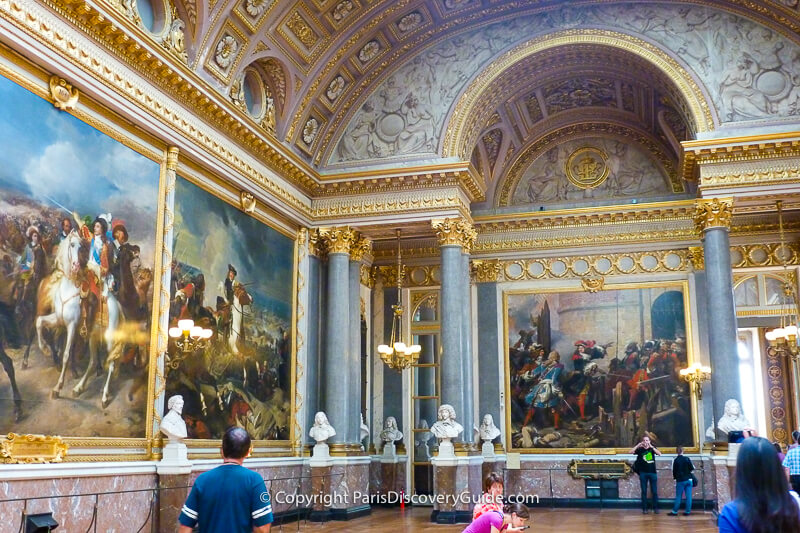
With so many beautiful things competing for your attention, focusing on individual pieces of art can feel challenging.
So what's the best approach for appreciating the Palace's extensive art collection?
Here's a pro tip: imagine that you're an art collector and just focus on one passion. Here are a few suggestions (but feel free to substitute your own favorites):
- Painted ceilings - you'll spot them in almost every room
- The 33 huge paintings depicting 1,500 years of French history in the Gallery of Great Battles, the largest room in the Chateau
- Fabric art, including tapestries, wall coverings, bed panels, and upholstery (hint: the Queen's Apartments offer many wonderful examples, thanks to Marie-Antoinette)
6. Royal Opera House
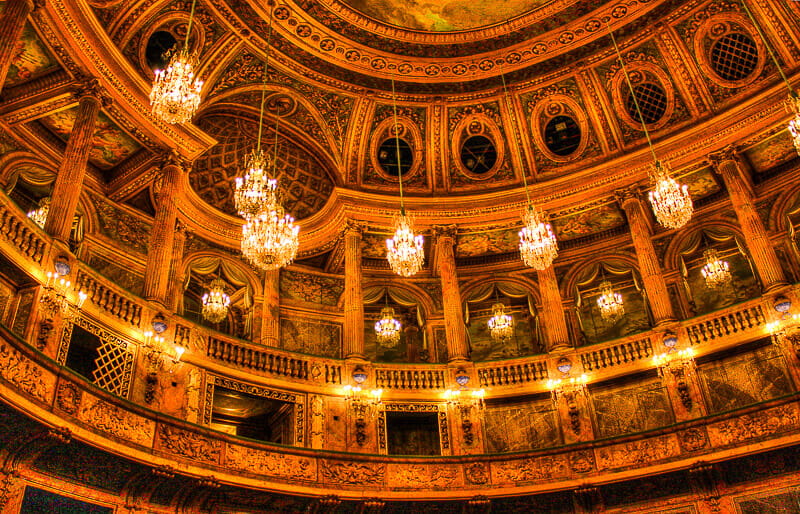
By the time Louis XV's reign began after his great-grandfather's death, the Chateau boasted many splendid things: 2,143 windows, 1,252 chimneys, 67 staircases, and enough space for 3,000 residents and up to 10,000 visitors in its staterooms.
But to Louis's great embarrassment, the Palace of Versailles lacked an opera house.
So naturally, despite France's increasing financial difficulties, Louis ordered construction of the Opéra Royal.
At its completion in 1770, just in time for the wedding of his son (the future Louis XIV) and Marie Antoinette who would later pay the ultimate price for royal indulgence at the expense of their subjects, it became the largest concert hall in Europe.
Today, the magnificent Royal Opera House continues to be used for ballet, concerts, and operatic performances.
When you visit, observe the elaborate decor, sparkling chandeliers, tiered seating, and spectacular painted ceiling featuring Apollo. If you have the opportunity to attend a performance, you'll love the superb acoustics.
Although Louis XV made other changes to the Palace, such as adding rooms in the attic to house his various mistresses, the Royal Opera is his signature contribution.
Get Your Versailles Tickets Now:
- Full-Day Guided Tour of Versailles- Guided tour of the Palace, Trianons, and Queen's Estate; transportation by private
- Skip-the-Line Versailles Palace Guided Tour- Guided tour of Palace plus access to Musical Fountains or Musical Gardens; travel by train from Paris
- Versailles Palace & Gardens: Ticket & Audio Guide- A guide whisks you through the fast-entry gate, and you explore on your own with an audio guide; luxury bus transport from Paris
- Day Trip from Paris to Giverny & Versailles Palace & Garden- Visit both attractions in one day
- Versailles Bike Tour with Palace & Queen's Farm Entrance - Bike tour of the Estate plus tickets to the Palace and Marie-Antoinette's Estate
- Versailles Sunset Bike Tour with After-Hours Palace Admission & Fireworks Show- Includes Musical Fountains at sunset and travel by train from Paris
- Versailles Palace & Gardens Skip-the-Line Guided Tour - Guided tour with fast-track access; choose a private or group tour, or opt for audio guides
- Paris Museum Pass - Free "Passport" admission to Palace, Trianons, Marie-Antoinette's Estate, Gardens (except on Musical Fountains and Musical Gardens days)
- Versailles Palace & Gardens Full Access Ticket & Audio Guide -Timed entry "Passport" ticket to the Palace and its Gardens (including a daytime Musical Fountains or Musical Gardens show if you go on a day when a show is scheduled), Trianons, and Queen's Estate; includes an audio guide.
7. The Gardens & Groves at the Palace of Versailles
In 1661, famed landscape architect André Le Nôtre began a project to totally transform the Palace's wild grounds.
Over the next 30 years, he created formal gardens with paths, planting beds, hedges, specimen trees, and water features.
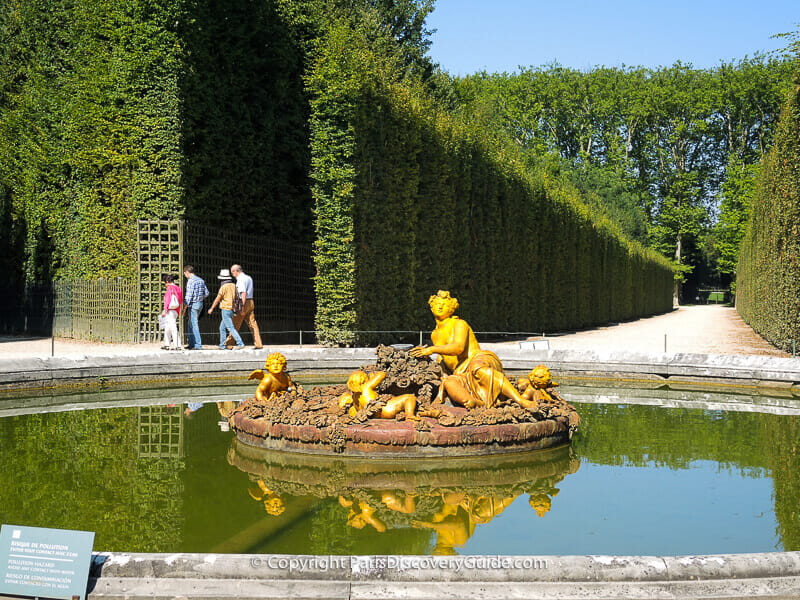
After reshaping the land, Le Nôtre used tall hedges and trees to create a grid of garden rooms divided by broad gravel paths and punctuated with pools and fountains.
Within the rooms (called "The Groves"), he positioned statues, planted themed gardens, and installed fountains. One, called the Ballroom Grove, even contains a sunken amphitheater with an 8-tiered cascading fountain.
Almost four centuries of revolutions, neglect, storms, and time took their toll. But happily, recent restoration efforts have repaired much of the damage, and the gardens you'll enjoy today are much like the original.
When you stand with the Palace at your back and look out at the expansive garden area, you'll see a grand tree-lined allée (alley) leading your eyes to the horizon.
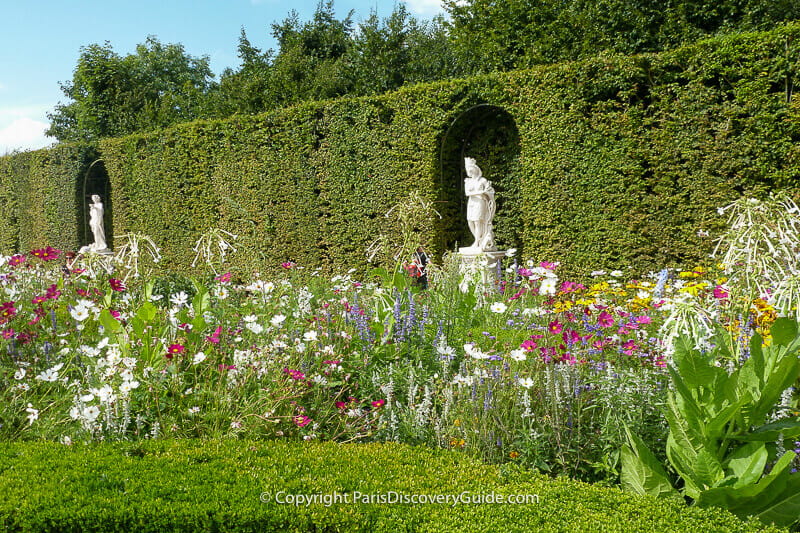
Near the Palace, you'll see broad swaths of statue-lined formal gardens. However, the magnificent walled Groves are hidden from sight - so if you want to see them, plan to spend some time exploring the grounds.
You can do this on foot, by hopping on the little train that circles the grounds, or on one of the bikes offered for rent by the hour. Golf carts are also available for rent, but sensors confine them to the main paths. However, you can easily pull over, park your cart, and walk into the "hidden" gardens.
The Groves continue down the entire length of the Grand Canal. Beyond that point, Versailles' massive park continues to the west.
Many of the Groves are open to the public only on Musical Gardens and Musical Fountains days - so make sure your tour or ticket includes this access if you want it.
8. The Grand Canal
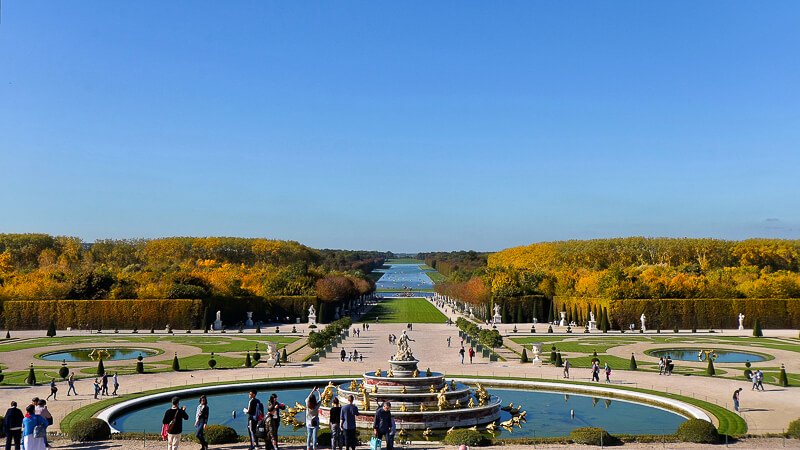
The grand allée called "The Royal Drive" forms an axis through the landscape. It begins as a gravel-paved path bisected by a 4-tiered fountain.
Past the gravel is an expanse of grass called "The Green Carpet," with marble statues lining the hedges and trees that form the walls of the "Groves," Versailles' hidden gardens.
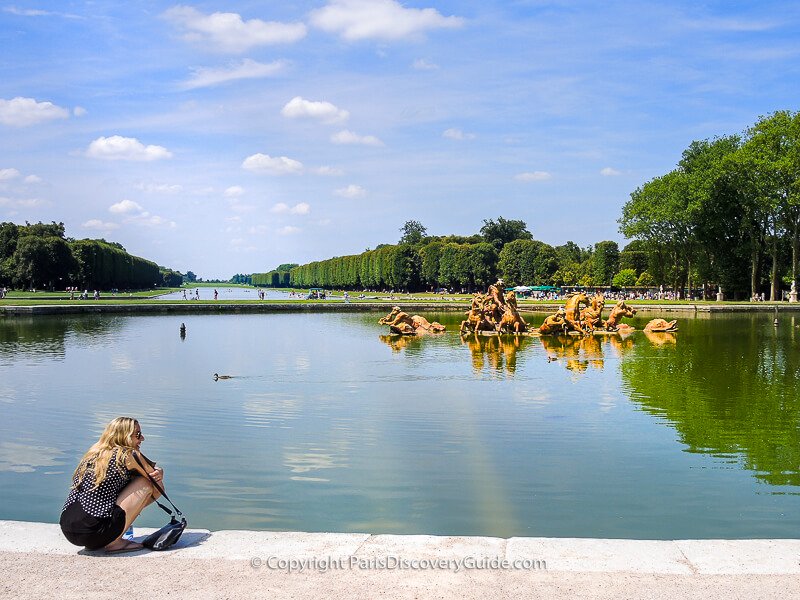
And finally, beyond the Apollo Basin, the Grand Canal stretches for more than a mile (1.65 km) to merge with the horizon - one of Le Notre's most brilliant landscape designs.
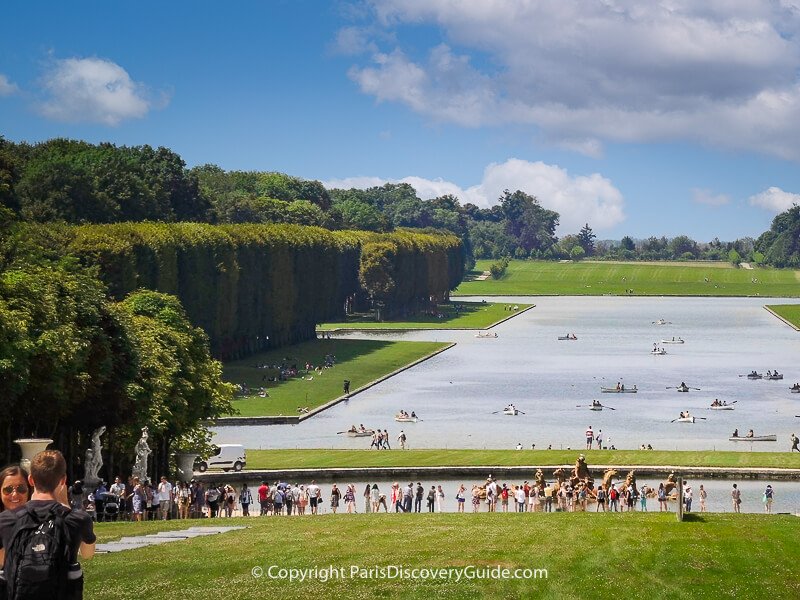
The grassy portion of the allée ends at a large round pool called the Apollo Basin. At its center, surrounded by water falling from a fountain, is a chariot by the Sun God himself.
As you may notice if you've ever seen paintings of Louis XIV, this sculpture of Apollo bears a striking resemblance to the "Sun King" as he holds the reins of galloping horses half-rising from the water. It's not a coincidence.
Walk around the Canal, enjoy the grand vistas, and find your favorite fountain. For the most memorable experience, rent a paddle boat and just float around in it.
9. Fun Activities on the Palace Grounds
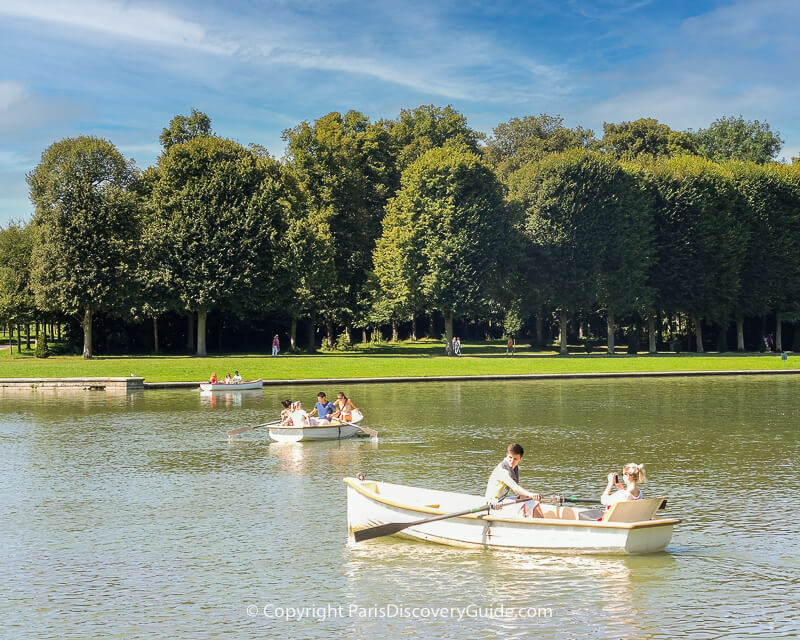
With so much spectacular art, architecture, history, and natural beauty to absorb during your Versailles visit, it's easy to overlook all the fun things to do while you're at the Estate. But that would be a mistake!
So set aside some time to enjoy Versailles' recreational offerings. Paddle around the Grand Canal in a row boat. Take a golf cart on a tour around the gardens and explore all their secluded "rooms." Hop on a bike for a ride through the Chateau's extensive parklands. Pick up some carry-out food and at the onsite cafe and find a grassy spot for a picnic.
These activities could become your favorite memories of your day at the Palace!
How to do it: Boats, golf carts, and bikes are available to rent by the hour behind the Palace.
10. Watch a Musical Fountains or Musical Gardens Show
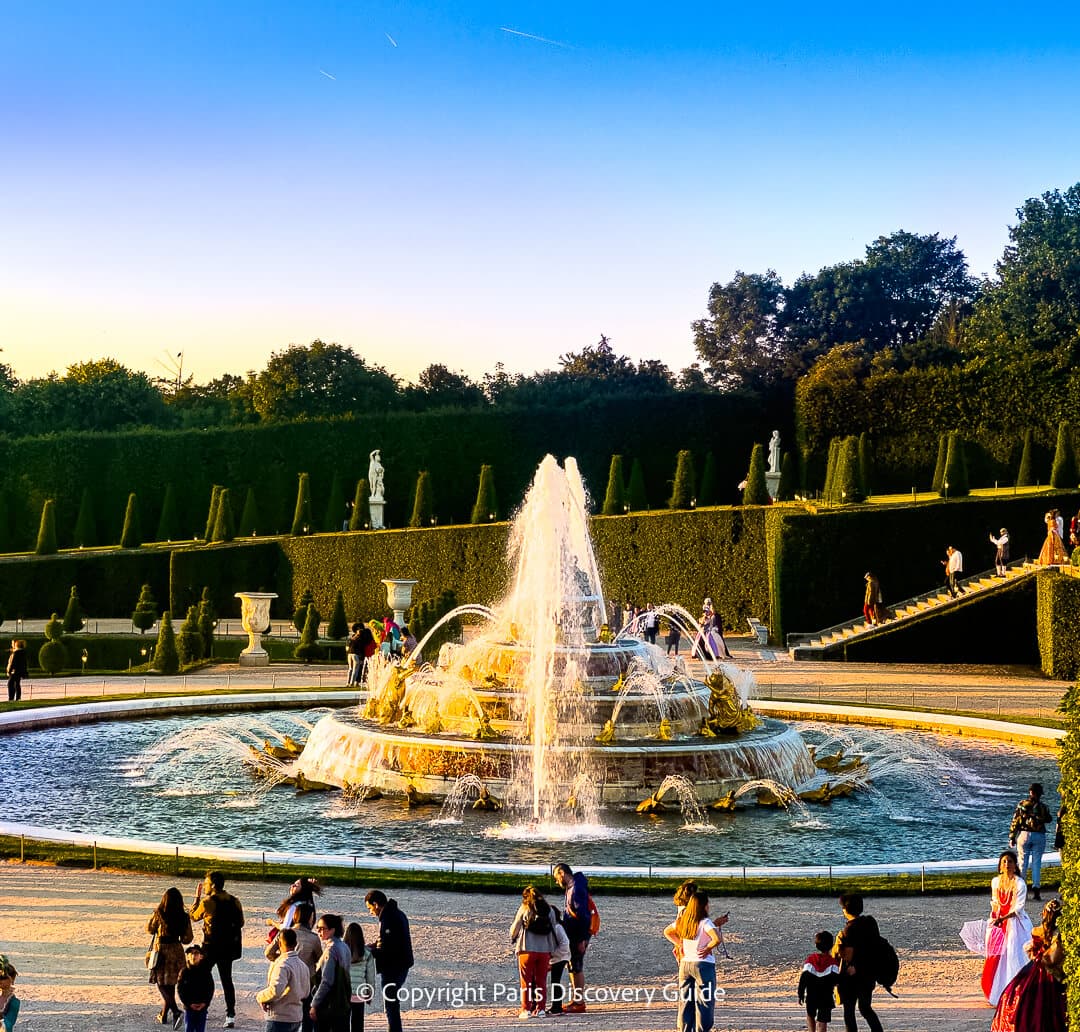
Night Fountains show at the 'golden hour' just before sunset
One of the best things to do at the Palace of Versailles is to experience a Musical Fountains Show or Musical Gardens show.
To see one of these special displays, book the Versailles Palace & Gardens Full Access ("Passport) Ticket & Audio Guide
During the Musical Fountains Shows, fountains in the Estate's gardens are programmed to spout water to the beat of Baroque music as you stroll along suggested paths.
The shows take place on Saturdays and Sundays from the last week in May through mid-October and on Bastille Day, July 14th.
Not all fountains will be on at all times during the day due to environmental considerations. To see all 32 functional fountains in play, be in the garden during late afternoon hours (3:30pm-5:30pm).
The Musical Gardens show gives you access to groves and gardens not usually open to the public. As you walk around admiring the beautiful flowers, sculptures, topiaries, and other hidden treasures, you'll hear Baroque music wafting through the air.
Musical Gardens take place on Tuesdays through Fridays during July (except for Bastille Day) and August and on Tuesdays, Thursdays, and Fridays during September and October.
So what's the best show to see? The Musical Fountains show focuses on water displays and baroque music.
With Musical Gardens, you get to see special areas that you can't access at other times while listening to the same lovely music Louis XIV might have heard.
11. See the Musical Fountains at Night with a Fireworks Show
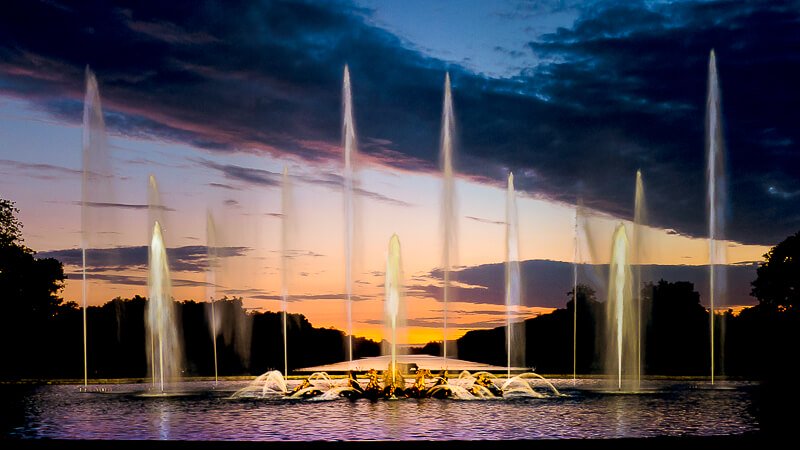
The Night Fountains & Fireworks show is an evening version of the Musical Fountains Show.
It takes place from 8:30pm-11:05pm (sometimes a little later) on Saturday evenings from early June through mid-September and on Bastille Day (and occasionally other special days).
If you come to the show in June when the sun doesn't start to set until around 10pm, you'll still have plenty of daylight during the first part of the evening and will experience a full "golden hour" right before sunset.
Later in the summer and early fall, the gardens will become dark much sooner and you'll have time to enjoy lighting and special effects such as lasers bring the Garden's fountains and groves to life as baroque music fills the air.
The evening concludes with a fantastic fireworks display in front of the Grand Canal.
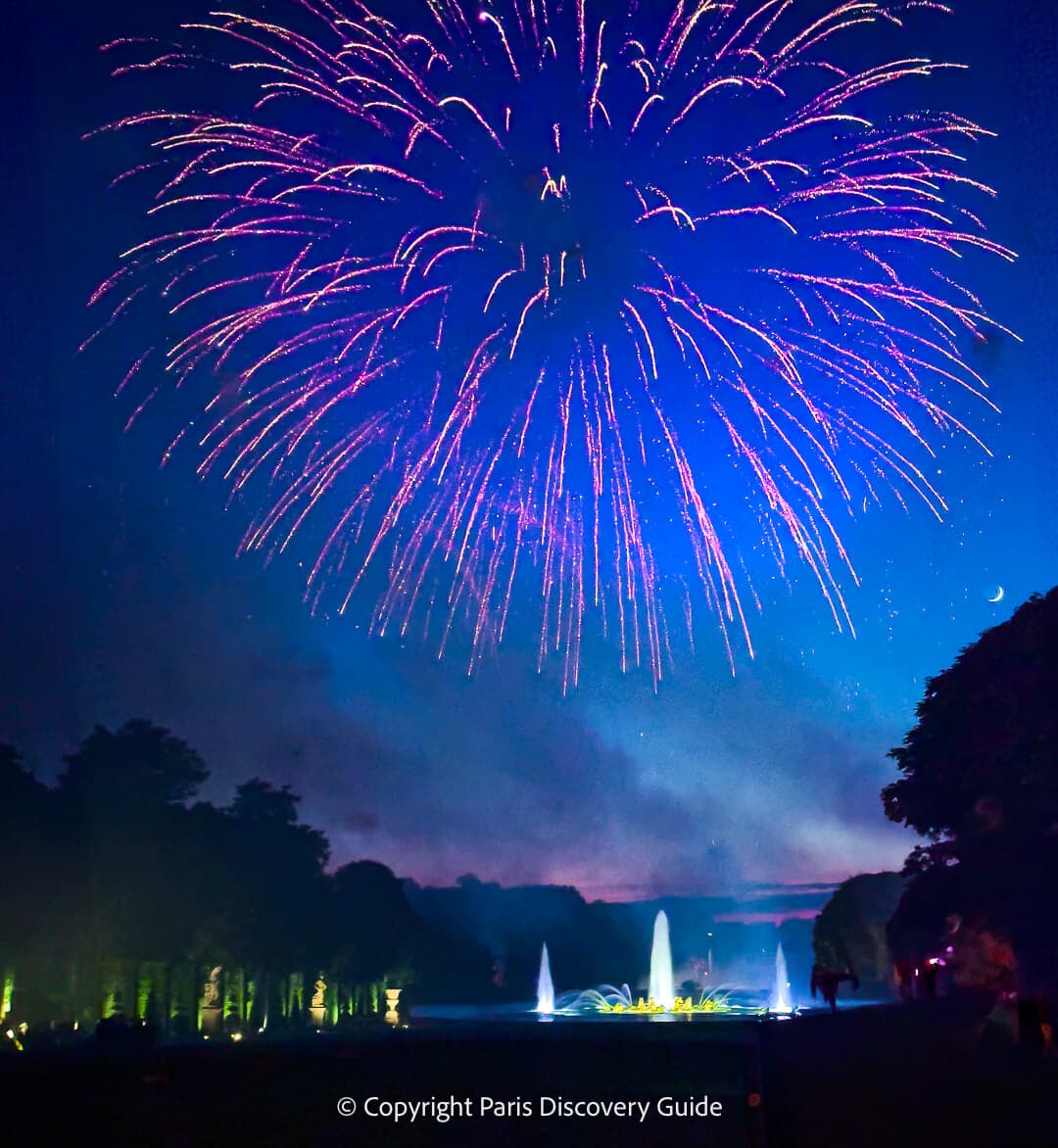
Tickets to the Night Fountains Show typically sell out very quickly, often weeks in advance, so if you want to see this dazzling spectacle, don't wait to book.
12. The Grand Trianon Palace
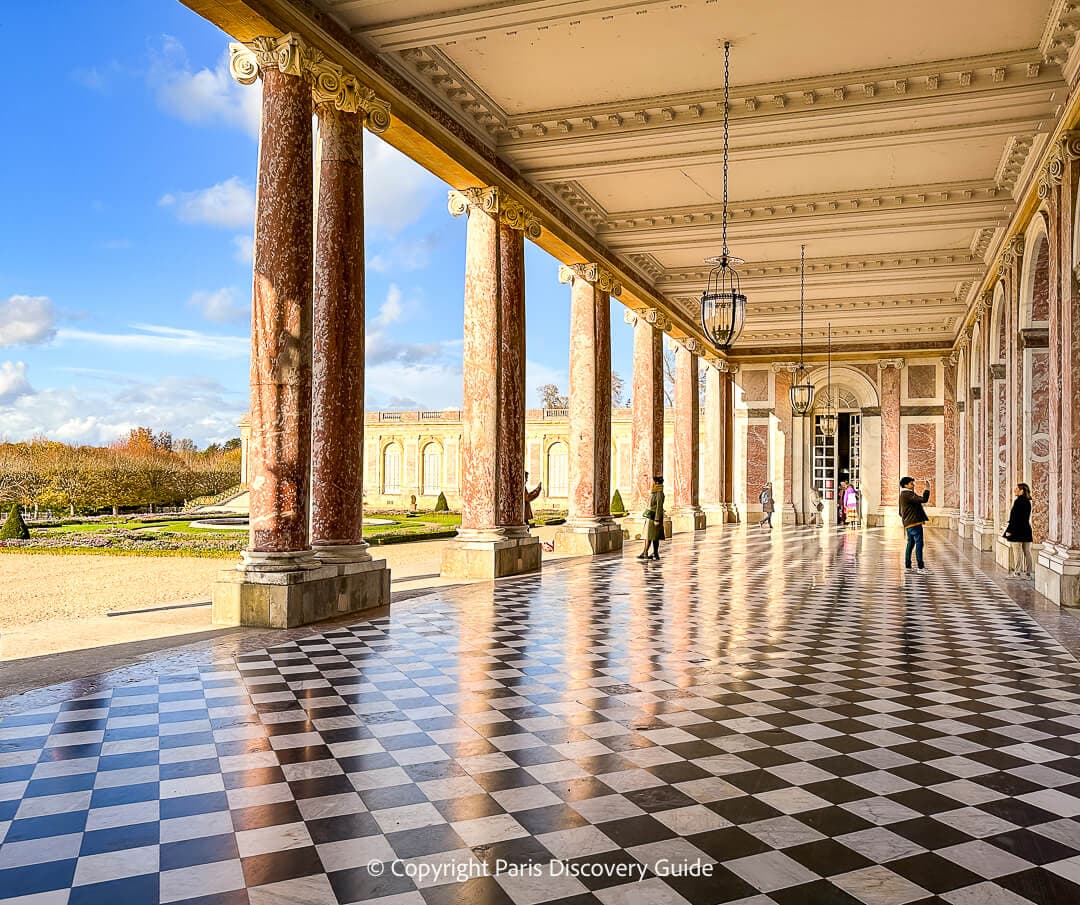
As much as Louis XIV loved Versailles itself, he grew tired of the rigid protocols and lack of privacy imposed by court life. Perhaps equally important, he needed a private place to rendez-vous with his mistress of that time, Madame de Montespan.
So, he asked architect Jules Hardouin-Mansart to build him "A little palace of pink marble and porphyry, with marvellous gardens."
Although the small palace was ready for use in 1670, it rather quickly fell apart, as did Louis's relationship with that mistress. The second iteration, completed in 1688, is what you see today.
The Grand Trianon has two large sections divided by a long Italian-style colonnade specifically requested by Louis.
In fact, Louis dictated many aspects of the charming single-floor structure, including the multiple floor-to-almost-ceiling windows, which we now know as "French doors."
He also designed the palace so that all rooms look out over the gardens filled with fragrant flowers.
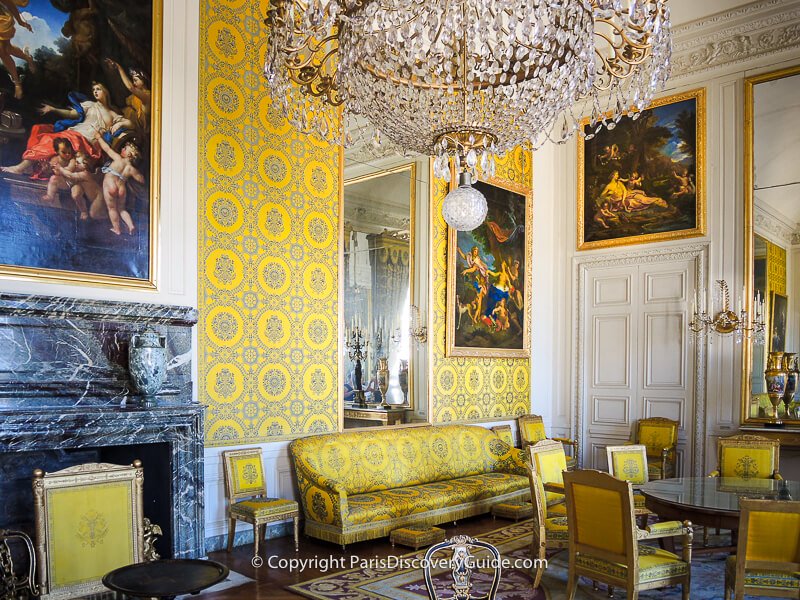
Through the centuries, the Grand Trianon has been home to various branches of Louis's family and their descendants, Napoleon Bonaparte and his second wife, and even King Louis-Philippe and his family after the Restoration.
Napoleon installed most of the First Empire decor and furnishings you'll see today, as the original pieces from Louis's tenure were sold during the French Revolution.
13. Petit Trianon Palace and Garden
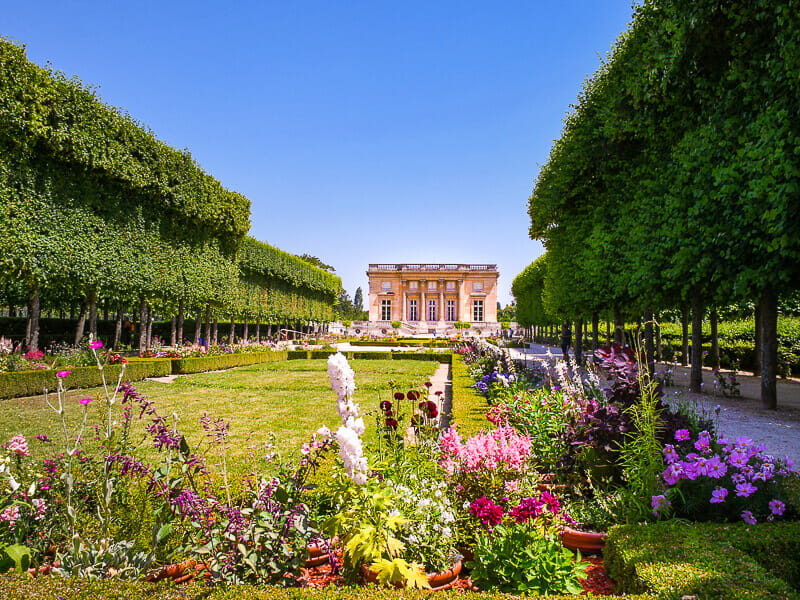
Although Louis XV built the Petit Trianon in the 1760s for his mistress during that period, Madame de Pompadour, she died before it could be completed, so her successor, Madame du Barry, lived there instead. A botanical garden, arboretum, and small ménagerie near Petit Trianon gave Louis, a devoted botanist, a place to pursue his hobby of creating rare plants.
However, the Petit Trianon is most closely associated with Marie-Antoinette, who received it and the surrounding gardens as a gift from Louis XVI when he ascended the throne in 1774.
They were only 19 and 20 at the time and already suffering from the royal court's pressures, constraints, conspiracies, and judgmental gossip.
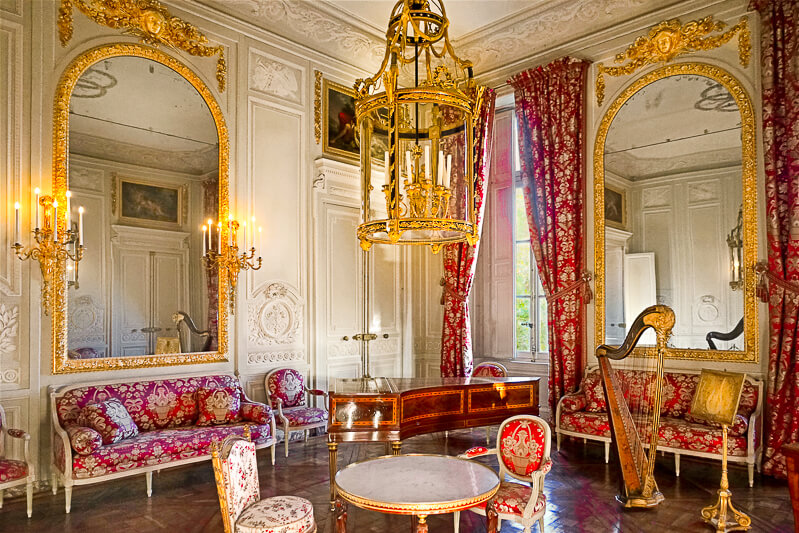
The Petit Trianon quickly became Marie-Antoinette's refuge. No one was allowed to enter without her express consent, and she invited only her closest friends - which increased resentment among the court's nobility.
She changed the garden to a more naturalistic English-style design, where Louis XVI liked to gather his own herbs.
Nearby, she added a small theater as a place to stage her own shows and a Greek-style "Temple of Love."
Close your eyes for a second, and imagine the young queen relaxing in her garden in 1789 when a page brought the news that an angry armed crowd would soon arrive from Paris.
She fled with her husband and their children on the following day, never to return.
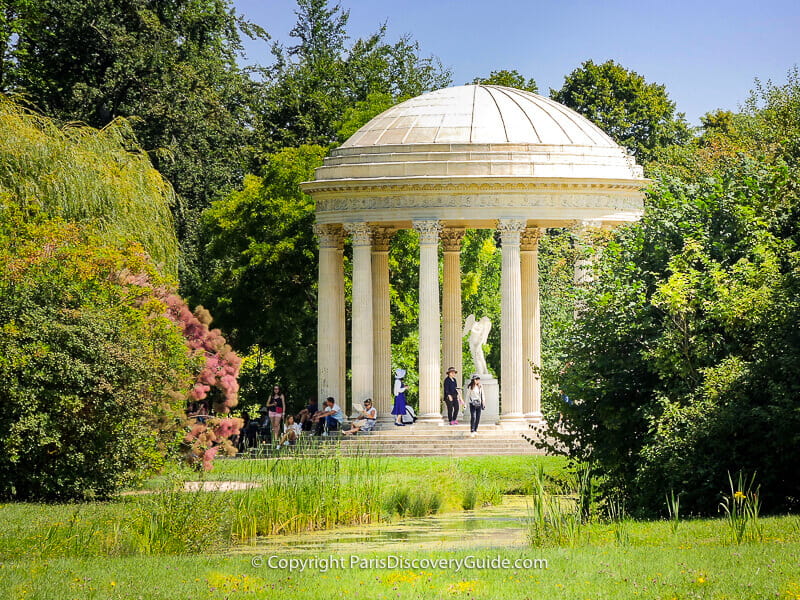
The Petit Trianon's furnishings, art, and ornamentation were sold at auction a few years later, and the property fell into neglect.
The palace remained unused until Napoleon renovated it as a residence for his sister Pauline.
Thanks to an extensive restoration a few years ago, both the palace and its gardens again look lovely.
14. Marie Antoinette's Hamlet (Hameau de la Reine)
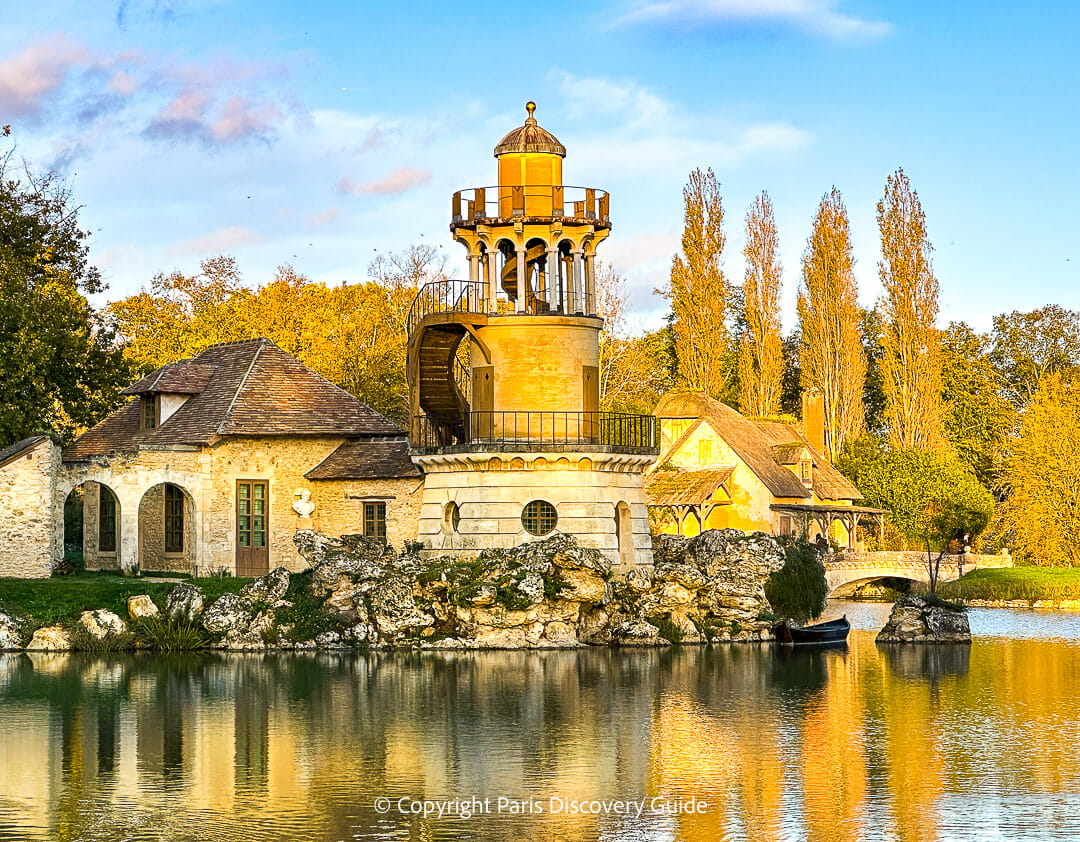
Thanks to artists and philosophers such as Jean-Jacques Rousseau and Diderot who romanticized country life, creating one's own rustic farm hamlet, or hameau, became trendy among the late-18th century French aristocracy who owned large estates and had enough funds to indulge this vision of "the simple life."
Marie-Antoinette jumped on board with this trend. Her picturesque Hamlet ("Hameau") included a dozen rustic cottages and buildings including a barn, mill, dairy, and dovecote.
Although she retained five buildings for her personal use, she used the others as part of a working farm which she managed along with a head farmer, herdsmen, gardeners, and laborers. The Hamlet's vegetable gardens, vineyards, fields orchards, and dairy produced much of the food consumed at the Palace of Versailles.
Restoration efforts during recent years have brought several of the original buildings and gardens back to life. The pigs, goats, cows, and other resident livestock add to the bucolic effect.
The Hameau gives you a fascinating glimpse of the charming rural landscape of the Queen's favorite part of Versailles - a life she might have preferred had she not been queen.
15. Versailles' Parklands on Horseback

For an unforgettable expience, consider booking a VIP horseback ride along beautiful trails through Versailles' magnificent parklands and gardens.
The Estate of Versailles covers more than 2,000 acres, so when you explore the Chateau's grounds by horseback, you see so much more than you can by walking or renting a golf cart.
Fair warning: This special experience is pricey - but your memories will be priceless. So if it's within your budget and you like riding horses, book it now!
The horseback ride starts from a private stable near the Waldorf Astoria Versailles-Trianon Palace - so for extra convenience, consider spending a night before or after your ride at this luxury 5-start hotel. Plus, you'll probably save money compared with comparable accommodations within Paris.
How to Visit the Palace of Versailles
Here's our "cheat sheet" to all the best ways to visit the Palace of Versailles:
Come with a Tour Group from Paris (Transportation Included)
What's the best, easiest, and most stress-free way to experience the Palace of Versailles?
If this is your first visit, book a guided walking or bike tour which includes transportation from Paris. Your expert guide will whisk you through a fast-track tour-only gate to save you from wasting time in line, lead you past the crowds inside the Palace, and make sure you get the most from your experience by giving you special insights and history about what you're seeing.
Guided Walking Tours with Bus or Train Transportation Included:
Here are several recommended options:
- Full-Day Guided Tour of Versailles - Includes travel on a air-conditioned luxury bus to and from Paris, guided tours of all the important Palace rooms, the Grand and Petit Trianons, and Marie-Antoinette's Estate, plus lunch. You'll have time to explore the Gardens on your own. Book now
- Skip-the-Line Versailles Palace Tour by Train - Includes travel by train with your guide from Paris, a 3-hour guided tour of the Palace, and a return train ticket to Paris. Explore the Gardens and see the Musical Gardens or Musical Fountains show, depending on the day of the week, on your own and return to Paris whenever you want. Book now
- Versailles Palace & Gardens: Ticket, Audio Guide, & Bus from Paris - This is a great choice if you want the convenience of bus transportation to and from Paris but prefer audio guides or exploring independently rather than taking a guided tour. Choose a full day excursion which includes entry to the Grand and Petit Trianons, as well as to Marie Antoinette's Estate, or a morning or afternoon (which include the Palace and Gardens including whichever show is scheduled for that day) tour. Book now
- Day Trip to Giverny & Versailles Palace & Gardens- Visit both Claude Monet's home and gardens at Giverny and the Palace of Versailles in one day from Paris. Includes luxury bus transportation to and from Paris and between Giverny and Versailles, tickets to both places, and lunch in Giverny. Choose whether you want an audio guide or guided tour when you book. Book now
Guided Bike Tours of Versailles (With Transportation Included)
Want to see Versailles the fun way?
On these guided bike tours, you meet your guide in Paris, travel to Versailles together on the train, pick up bikes and buy food for a picnic meal, and then you'll get a guided tour by bike of the Estate (except for the Palace and Gardens where bikes are prohibited).
You'll also get an entry ticket to the Palace (which you can explore on your own) and a return train ticket for Paris.
Here are three popular choices:
- Versailles Bike Tour with Palace & Queen's Farm Entrance - A wonderful bike tour of the Estate plus entry tickets to the Palace and Marie Antoinette's Hamlet and Farm where you can explore on your own
- Skip-the-Line Versailles Bike Tour & Guide - On this small-group tour, your guides will customize the day according to the group's interests - but typically, you'll explore the Gardens, Trianons, and Marie-Antoinette's Hamlet as part of a guided bike tour, and explore the Palace with a guide (or on your own, if you prefer), enjoy a picnic with wine tasting, and return together to Paris at the end of the day.
- Paris: Versailles Sunset Bike Tour with Fireworks Show - After a fun bike tour and picnic dinner with your guide, you'll get an entry ticket to the Garden where you can see the Musical Fountains Show and exclusive after-hours admission to the Palace where you'll see costumed performers and musicians as you explore the Hall of Mirrors and other famous rooms. Your evening ends at dark with a spectacular fireworks and lights show over the Grand Canal.
Travel to Versailles on Your Own & Take a Guided Tour
Travel to Versailles on your own and meet up with your guide, who will take you through the fast-track tour entrance. You'll then have a guided tour of the most important rooms as your guide whisks you around the crowds and shows you things you might miss on your own.
Here are two excellent choices:
- Versailles Palace: Skip-the-Line Guided Tour - Guided tour of the Palace; choose to do this with a group or as a private tour. Please note: A ticket for Garden access (when one is required) is not included - so if you want that, see the tour below. Book now
- Versailles Palace & Gardens Skip-the-Line Guided Tour - Same as the above tour but also includes Garden access and Musical Fountains or Musical Gardens, if available (depends on day and season). Book now
Get Skip-the-Line Tickets & Come on Your Own
- Versailles Palace & Gardens Full Access Ticket & Audio Guide - This "Passport" ticket gives you access to the Palace, the Grand and Petit Trianons, and Marie Antoinette's Estate plus you get an audio guide. You can also upgrade to include the seasonal Musical Fountains or Musical Gardens if available (we highly recommend doing this). The timed-entry reduces your wait in line.
- Versailles Palace Skip-the-Line Entrance & Breakfast at Ore - You start with breakfast at the Alain Ducasse restaurant Ore, and then get skip the line access to the palace where you can explore its magnificent rooms on your own. You also get access to the gardens, but only if you're there on a day when the Musical Fountains or Musical Gardens shows are not scheduled.
Find out more about getting to Versailles on your own
Can You Use Your Paris Museum Pass for the Palace of Versailles?
Yes, the Paris Museum Pass gives you free entry to the Palace of Versailles, but there are a couple of things you should know:
- With the Paris Museum Pass, you get free entry to Versailles Palace and the Trianon Estate including the Grand and Petit Palaces, but not to Marie Antoinette's Estate. It also does not include the Gardens or Groves during the Musical Fountains or Musical Gardens.
- Although the Paris Museum Pass gives you skip-the-line entry to Versailles, you must still go through the security line. Fortunately, timed-entry slots make that process much faster than it used to be, but occasional glitches can cause a longer wait, especially during peak tourist season.
Find out more about the Paris Museum Pass
When is Peak Tourist Season at Versailles?
During a typical year, the number of visitors to the Palace of Versailles peaks between early April through late October. Yes, that's a very long period - but Versailles is extremely popular.
During that period, July and August are the very busiest months when lines will be the longest.
Although there's no such thing as a "slow" day during these periods, the biggest crowds typically occur on weekends. Tuesdays, when the Louvre and a number of other Paris museums close for the day, can also be extremely busy.
Palace of Versailles Fun Facts
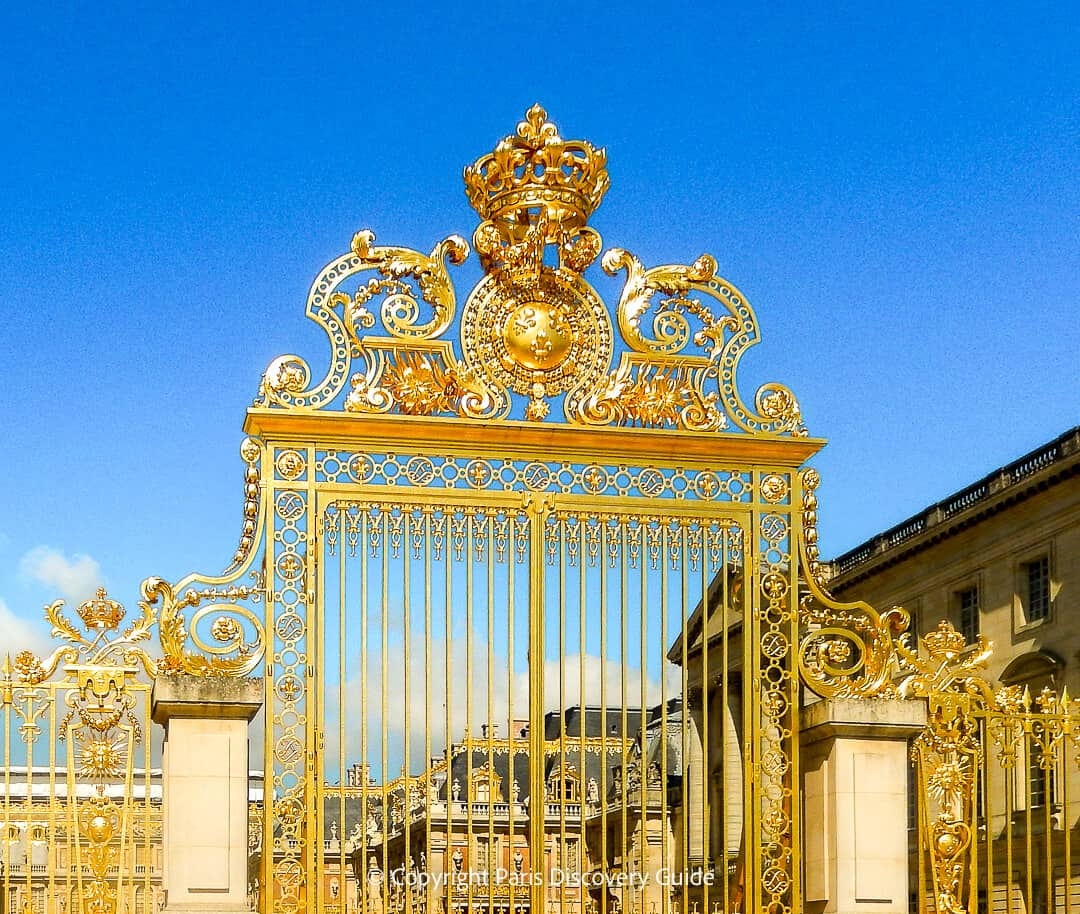
- The beautiful golden gate you pass through when you enter the Palace grounds is a copy of the original, destroyed during the French Revolution.
- Versailles Palace covers about 721,206 square feet (67,002 sq m). In comparison, the average single family house in the U.S. contains about 2,300 square feet (217 sq m). You could fit more than three average U.S. single family houses into the Hall of Mirrors (8,256 sq ft/767 sq m).
- Louis XIV began using his father's hunting chateau at Versailles as a place to tryst with his mistress in the early 1660s. He decided renovations, additions, and landscaping were necessary to make the place fit for a king. One thing led to another and by 1678, Louis realized he could control the rebellious nobility and government officials by moving them, their families, and their entourages from Paris to the more isolated countryside - a "keep your enemies close" tactic that required additional expansions of the Palace.
- Louis XIV believed he ruled by "divine right" and cast himself as the "Sun King." Not surprisingly, you'll see lots of depictions of Apollo, the Sun God from Greek mythology, as you tour the Palace and Gardens. So consider this: Apollo was Louis's alter ego, and Versailles was the temple he created for himself.
- In addition to becoming the center for much of France's best art (at one point, the Mona Lisa in the Kings State Apartments), Versailles Palace boasted over 100 libraries containing more than 200,000 books and manuscripts before the French Revolution, according to a post-Revolution inventory. The palace even became a museum for a few decades starting in 1837. Today, you can still see three of these libraries in the Royal Chambers - but most of the books are now fake. The originals were moved to the National Library. Although much of the art is now in the Louvre Museum, plenty of it remains on display at Versailles.
- Although 17,182 pieces of the palace's art, furnishings, and decor were removed and sold after the Revolution, the French government decreed in 1962 that all items originally belonging to Versailles be returned from other museums throughout France. An ongoing effort to acquire furniture and other objects from private collections continues today, as does the restoration effort to replace wall coverings and other ornamentation. So when you tour the many rooms of the palace now open to the public, much of what you'll see (except for the books) is original and almost exactly like it was on October 6, 1789 when Marie Antoinette, Louis XVI, and their son fled from the angry mob of Parisians who stormed the palace demanding bread.
- Not sure if this is a "fun" fact about Versailles - but among all those rooms filled with gold and silver furnishings, priceless tapestries, and art during Louis XIV's reign, there were no bathrooms, no toilets, and certainly no modern plumbing or effective sanitation system for the 7,000 - 10,000 people who lived and worked there. Only a few hundred of the top nobility had chamber pots, and chambermaids typically dumped the contents out the nearest window - so imagine if you happened to be standing below it. Everyone else relieved themselves in communal latrines or wherever convenient - under stairways, in secluded halls or a momentarily unoccupied room, or perhaps outdoors. You had to be very, very careful about where you stepped - and not become overwhelmed by the stench. Something to think about when you use the clean, modern toilets available throughout Versailles today!
- Sanitation began to improve under Louis XV, the great-grandson of Louis XIV. In 1738 he installed a flush toilet ("water closet") imported from England that dumped water from an overhead tank into the toilet and then down into drains, which eliminated lingering odors from his apartment - although most of the castle continued to reek from the open latrines (and worse) still in use elsewhere.
- In 1763 when Wolfgang Amadeus Mozart was only seven, he played a concert for Louis XV's daughters, Adélaïde and Victoire, both of whom were accomplished musicians, in their private sitting room at Versailles.
FAQs: Chateau de Versailles
Q: How many people visit Versailles each year?
A: Over 15 million visitors come during a typical year. For context, Versailles attracts the second highest number of visitors in the Paris region, placing it behind the Louvre Museum and ahead of the Eiffel Tower.
Q: How large is the Estate of Versailles?
A: The Palace of Versailles and its grounds cover 2,014 acres (815 hectares).
Q: How much did Versailles cost to build?
A: No one really knows due to the difficulty of 1) calculating the cost of materials and labor during that time, and 2) performing accurate currency conversion from the 1600s to present day value.
But estimates by experts range from about $4.8 billion (in 2025 U.S. dollars) to perhaps as much as 100 times that amount. Yes, that's a staggering $430,000,000,000 - approaching one half of a trillion dollars.
The expenditures, along with other disastrous losses to Great Britain during the Seven Years' War, destroyed the country's finances.
You can easily draw a straight line from the excesses of the absolute monarchs in the 1600s to the bankruptcy of the French government in 1788 to the outbreak of the French Revolution in 1789.
Sometimes, following the money tells you everything you need to know about history - in particular, revolutions, wars, and regime changes.
Q: How long did construction take?
A: Construction of Versailles began in 1661 and by 1682, expansion of the former hunting lodge progressed enough to enable Louis XIV to move his Royal Court plus the entire French government to the new palais. However, additional construction and renovations continued up until the beginning of the French Revolution in 1789. About 36,000 workers contributed the effort during the century-plus construction period.
Q: How many rooms does the Palace of Versailles have?
A: When Louis XIV moved in: Around 700, plus 67 staircases and about 1,250 chimneys. Worth noting: despite all those chimneys, the palace was notorious for being punitively cold during the winter - so frigid, occupants claimed, that glasses of wine placed on tables would freeze before they could be drunk.
Today, after major expansions that continued until 1789: Around 2,300 rooms.
And if you're visiting during winter months, you'll be glad to know that ongoing updates have included an effective heating system.
Q: How many people lived at Versailles during Louis XIV's reign?
A: During Louis XIV's tenure, the main palace could accommodate about 5,000 residents including servants, although another 2,000 - 5,000 worked there in therooms used at French government offices.
Another 17,000 soldiers and servants occupied annexes and quarters in the nearby town of Versailles.
Versailles Visitor Information: Tickets, Hours, Location
Ticket Information
At this time, all tickets must be bought online. If you book a guided museum tour, your ticket will be included.
Palace,,Trianon, and Marie-Antoinette's Estate admission is free to all visitors under 18 years old, EU citizens (or long-term residents) between 18 and 25 years old, and holders of a valid Paris Museum Pass (who must also reserve a date/time online); however, tickets are required for Musical Fountains and Musical Gardens shows regardless of age or citizenship/residency.
Find out more about the best Palace of Versailles Tours
Schedule for Visiting Palace of Versailles, the Trianons, Gardens, & Park
If you're planning a visit, be aware that the Estate of Versailles has two seasons, each with its own hours: High and Low.
High Season Opening and Closing Times at Versailles & Estate of Trianon
Dates: April 1 - October 31
Days open: Tuesday through Sunday
Days closed: Mondays
Hours open: Palace: 8am - 6:30pm; Gardens: 8am - 8:30pm (except on Night Fountains dates); Trianons: 12 noon - 6:30pm; Park: 7am-8:30pm
Low Season Opening and Closing Times at Versailles & Estate of Trianon
Dates: November 1 - March 31
Days open: Tuesday through Sunday
Days closed: Mondays
Hours open: Palace: 9am - 5:30pm; Gardens: 8am - 6pm; Trianons: 12 noon - 5:30pm; Park: 8am-6pm
Free Access to the Gardens
Access to the Gardens is free except during Musical Gardens (Tuesday to Friday) and Musical Fountains (every weekend).
Musical Gardens and Musical Fountains usually take place every week between late March and late October (with the exception of unusual circumstances, such as extreme drought).
In other words, during the summer period, the only day when you can access the Gardens for free is on Mondays when the Palace itself is closed.
However, it's worth pointing out that tickets to the Musical Gardens and Musical Fountains shows are relatively inexpensive and the experience of seeing them is magical. We always consider the cost of the tickets to these shows to be money well spend!
Closed
January 1, December 25
The Palace and Trianons are closed on Mondays, although the Gardens and The Park (the vast area beyond the Gardens) are open every day except during exceptionally bad weather such as snow, flooding rain, violent wind) or for other unusual reasons.
More Information
Access to the Estate of Versailles and its related attractions can change without notice for a variety of reasons including weather, strikes, and other conditions. It's always a good idea to check opening/closing information on the Versailles website before you go.
Palace of Versailles Address & Transportation
Location: Place d'Armes, 78000 Versailles, France
Getting there: 6 best ways to get from Paris to Versailles by tour bus, train, bike, & more
Map Showing Palace of Versailles,Grand Trianon, Petit Trianon, Hamlet, & RER Train Station Locations
Things to Know Before Your Visit
- The following items are not allowed inside the palaces and gardens: pets, weapons or sharp objects, baby strollers, food and drinks, luggage or large bags (see next item below), selfie sticks, high-heeled shoes, or umbrellas
- A storage office is located near the entrance for smaller items such as baby strollers, handbags, backpacks, and food
- Due to security considerations, bags must be smaller than 55 x 35 x 25 cm (21.7 x 13.8 x 9.9 inches); larger bags cannot be stored
- Once you leave the palace and other ticketed areas (such as the Trianons), you can't re-enter with the same ticket.
- You can enter the Palace Gardens for free on days when Musical Gardens or Fountain Shows are not scheduled; currently, free entry days include Wednesdays during September and October, and every day from November through March
Where to Stay near Versailles Palace
Whether you want to spend more than one day exploring the Chateau de Versailles, arrive as early as possible, or have a late dinner in town and head back to Paris the next day, you'll find plenty of wonderful places to stay near the Estate.
As a bonus, rates are noticeably cheaper than in Paris, so in addition to the convenience, staying in Versailles is an smart (and easy) way to save money.
Here are several top choices:
- Hôtel Le Louis Versailles Chateau MGallery - This charming 4-star mid-sized hotel offers an ideal location between the Rive Gauche RER station and the Palace of Versailles, plenty of amenities, and excellent service.
Book best deals - Hotel d'Angleterre - This popular 2-star hotel offers simple and rather basic accommodations at cheap (even for Versailles) rates. All rooms have private baths, but the hotel does not have air-conditioning or an elevator.
Book great deals - Le Logis Versaillais Apartments - These 12 attractive modern apartments overlooking a quiet paved courtyard range in size from studios to 1-bedrooms and feature modern decor and kitchenettes.
Find best rates
Find more hotels and apartments near Versailles - including a new, super-luxurious 5-star hotel inside the Palace of Versailles itself!
Map Showing Paris Hotels
Use this Versailles hotel map to find more places to stay near the Palace. Enter your check-in date for your visit to see what's available:
Booking.comFind more hotels in Paris & at other day trip destinations
More Famous French Palaces & Chateaus to Visit
Did you know you can easily visit other French châteaus and castles from Paris? Here are several fantastic places to consider:
- Loire Valley Castles Small Group Tour - Visit the magnificent castles of Chenonceau, Amboise, and Chambord, learn about court life, and see the lovely Loire Valley and its charming villages on this small-group tour limited to 8 visitors.
- Fontainebleau & Vaux-le-Vicomte - See two of France's most celebrated chateaux: Château Fontainebleau, a UNESCO World Heritage site famous for its gardens, splendid furnishings, and eight centuries of continuous occupancy by French royalty; and Vaux-le-Vicomte, the inspiration for the Palace of Versailles.
- "Enchanted Kingdom" - If you're traveling with kids, Disneyland Paris, with its fairytale-like pink castle, may be their favorite chateau in France, and it's within easy reach of the city. Opt for a full-day ticket with transportation services by a private chauffeur/guide to and from your hotel or apartment in Paris - or get just Disney entry and round-trip train (RER A) tickets and make the 40-minute trip on your own.
- Chateau de Vincennes - Part medieval castle, part fortress, and eventually a prison, this former hunting lodge at the edge of the Bois de Vincennes in the 12th arrondissement was the home of 12th and 14th century French kings. You won't find fancy furnishings like at Versailles, but the 14th century fortified tower is the highest of its type in Europe. How to get to the castle? Just take the Metro to the end-of-the-line Chateau de Vincennes station.
More Articles about Other Top Paris Attractions
- Best Versailles Palace Tours from Paris
- How to Get from Paris to Versailles Palace - 6 Options
- Where to Stay near the Palace of Versailles - From budget to luxury
- Paris Museum Pass - How much money and time can you save with it?
- How to get fast entry to top Paris attractions with skip-the-line tickets
- Easy day trips from Paris to Versailles, Giverny, Mont Saint Michel, D-Day Normandy Beaches, Disneyland, London, Bruges, & more


